Faha’s analysis of the first 9 constituencies for the May elections. We were awaiting publication of the latest electorate statistics due to be published yesterday but these have not materialised so here goes: Part two will follow shortly looking at the greater Belfast area – BD
This is my analysis of next week’s Assembly election. I have included the demographics of the voting age population for each constituency as well as election results going back to at least the 2010 Westminster election. In some constituencies I have included demographic information from the 2001 census or election results further back than 2010. This analysis is for the 9 constituencies outside of the Belfast area.
Mid Ulster
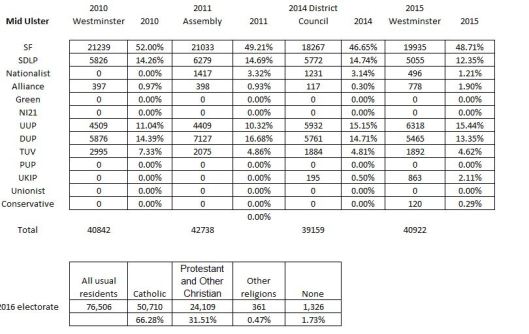
Mid Ulster is the most predictable of all the constituencies. Since there are 3 SF candidates and 1 SDLP candidate there will be 4 nationalist MLA’s elected as the total nationalist vote is far above 4 quotas. The total unionist vote also far exceeds 2 quotas. The vote is likely to be similar to the 2014 District Council results and with those results the 3 SF, 1 SDLP and 1 UUP candidates could all be elected on the 1st count. One of the 2 DUP candidates will also be elected on a subsequent count. The only thing to watch for here is to see if the nationalist vote increases to its share of the electorate population. The unionist vote has been over 35% recently and the electorate numbers suggest it would be only 32% if nationalist turnout equaled unionized turnout.
West Tyrone
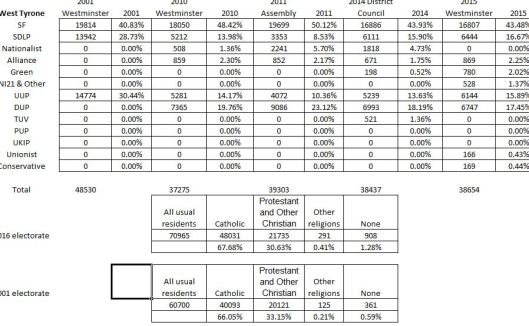
In West Tyrone there are 4 SF, 1 SDLP, 1 UUP and 2 DUP candidates. This election has become complicated due to a SF councilor, Sorcha McAnespy, resigning from the party to stand as an independent based in Omagh Town. Shortly after her decision, 2 SDLP councilors. Dr. Josephine Deehan and Patsy Kelly, also resigned from the SDLP and will stand as independents based in Omagh Town and Strabane Town respectively. There are also 7 other candidates from the Alliance, Green and minor parties and other independents standing. Despite the plethora of candidates the recent election results from 2014 and 2015 give a good indication of the results in this election. SF have been slightly above 3 quotas in the 2014 Council and 2015 Westminster elections. While Sorcha McAnespy will receive enough votes to lower that slightly SF should still elect 3 with her transfers and transfers from the minor party candidates. The DUP are standing 2 candidates but it is not possible to elect 2 as the UUP were above a quota in the 2015 Westminster election and just short of a quota in the 2014 Council elections. The fact that the UUP is opposed to Brexit will also help them with unionist farmers.
The situation is more complicated for the SDLP. The SDLP vote was 16.67% in Westminster in 2015 and with transfers from Alliance, Green and independents their vote in a STV election would have been approximately 19% which is well above a quota. It is not clear how much of the 1st preference SDLP vote will go to the 2 former SDLP councilors. Josephine Deehan will probably be the stronger of the 2 and it is possible that Daniel McCrossan will have less than a quota on the 1st count. Nevertheless he will still receive transfers from Alliance, Green and other minor candidates so he should be elected.
I included the results of the 2001 Westminster election to illustrate an important point. The SF vote declined by 3,000 from the 2001 election to the 2015 election. The SDLP vote also declined by 7,500. It is a myth that the SDLP voters have defected to SF. The vote of both parties is down by almost 11,000 compared to 2001 but many more SDLP voters are staying home compared to SF voters. You will also notice that the Catholic electorate has increased by 8,000 since 2001 but despite that large increase the total nationalist vote has collapsed. Turnout was 85% in 2001 but only 50% in 2015. In contrast there has been little decline in the unionist vote, only 1,600 since 2001. The unionist electorate has increased by only 1,600 since that time compared to the nationalist increase of 8,000. Unionist turnout was 75% in 2001 in 2001 but has only declined to 60%. It would require a nationalist turnout of 67% to elect a 5th nationalist MLA (either SF or an independent). Brexit could motivate an increased nationalist turnout as a hard border with Donegal is undesirable from a nationalist viewpoint but I doubt that it would increase to a level that high to elect a 5th nationalist MLA.
East Derry
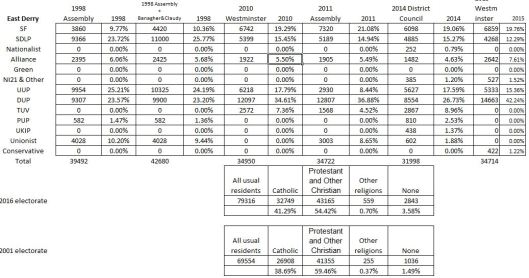
This constituency is likely to have some changes compared to 2011. If you look at the 2014 Council results the DUP is at 26.7% which is 2% less than 2 quotas. The UUP was at 17.6% which is 3.3% over a quota. The TUV received 9% with another 4% going to UKIP and the PUP. Since all those parties are competing for the Assembly election it appears that the DUP will elect 2 with 1 for the UUP and 1 for the TUV. The TUV are likely to receive the majority of the UKIP and PUP transfers and should be at 12% at some point in the count. Claire Sugden is standing as an independent but it is likely that many of her transfers will go to the UUP so 1 UUP should be elected.
The nationalist vote is straightforward. The SDLP have only 1 candidate and their vote was above a quota in 2014 so he should be elected. SF are standing 2 but are far short of 2 quotas. However, excluding the Others and None’s the religious background in 2016 is 43% Catholic and 57% Protestant. So theoretically there could be 3 nationalist quotas. This will not occur for several reasons. The main reason is that the nationalist turnout is much lower than the unionist turnout. The Catholic community electorate has increased by almost 6,000 since 2001 but the Protestant community electorate has increased by less than 2,000. Despite the large increase in the potential nationalist electorate the combined SF-SDLP vote is down over 4,000 within the current boundaries in 2015 compared to 1998. The combined unionist vote is down by approximately the same amount. In 2015 unionist turnout was 50% and nationalist turnout only 36%. In the Coleraine, Portrush, Portstewart and Limavady Town areas nationalist turnout was only 25%. That is a level only seen with organized election boycotts. SF has little presence in the urban Coleraine region and did not even have a council candidate for the Causeway DEA in 2014. Also the 2nd SF candidate would be dependent on Alliance transfers for election and few of those will transfer to SF although it is also true that few would transfer to the TUV.
Unfortunately nationalist voter apathy will result in a seat for the TUV. I hope the TUV candidate has the courtesy to thank the stay at home nationalist voters for his election.
Fermanagh South Tyrone
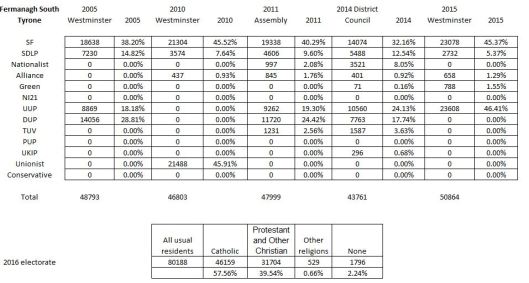
This constituency has the highest voter turnout of any. It is difficult to predict whether the DUP or UUP will win 2 seats. There are 3 factors that favour 2 for the UUP. In the 2014 Council election the UUP vote exceeded the DUP vote by over 6%. The UUP would also receive some Alliance transfers adding to their total. The UUP stood as the unionist unity candidate in 2015 and some votes lent by the DUP for that election may not return to the DUP. However, the DUP have one major factor in their favour and her name is Arlene Foster. Since she is now the leader of the DUP and probably the new First Minister at Stormont she will have a very high 1st preference vote. This could work against the DUP since if she is far above a quota the UUP could receive some of her transfers. If the UUP candidates are evenly balanced they could also win 2 even if the combined UUP vote is slightly less than the DUP vote.
On the nationalist side it is unlikely that SF will win 3. If you look at the 2014 Council vote the SDLP received 12.54% and after Alliance and Green transfers would be only 1% short of a quota. In the 2011 election the SDLP also received a few UUP transfers so they would be just shy of a quota. SF only received 32.14% in 2014 with 8% going to independent Republicans. It is unlikely that all of that 8% would go to SF. Even if they all vote SF the SF total would be 40% and they would be 3% short of 3 quotas. The only way that SF can elect 3 is by a higher nationalist turnout. In 2015 the unionist turnout was 75% and the nationalist turnout was less than 60%. Excluding the Others and None’s the religious breakdown is 59.2% Catholic and 40.8% Protestant. If the turnouts were equal there would be 4 nationalist quotas with another 2% to spare. That translates to an additional 4,500 nationalist voters. Are there any factors that could increase nationalist turnout? The first factor is that there is a large group of voters who were not eligible to vote in the Westminster election. These are EU nationals and there are currently 3,500 who are on the Fermanagh South Tyrone electoral register. These voters are very concerned about the Brexit referendum since a vote in June in favour of Brexit would seriously jeopardize their status in Northern Ireland. The possibility of loss of one’s job and potential deportation would be a strong motivation to vote. They are not eligible to vote in the Brexit referendum but can vote for pro EU parties in the Assembly election. If 2,500 of these voters voted for SF or the SDLP then the number needed to elect 4 nationalist MLA’s would be reduced to only 2,000. That 2,000 is still a large number but the possibility of restricted border crossing with the Republic of Ireland might motivate some native nationalist voters to vote also.
Foyle
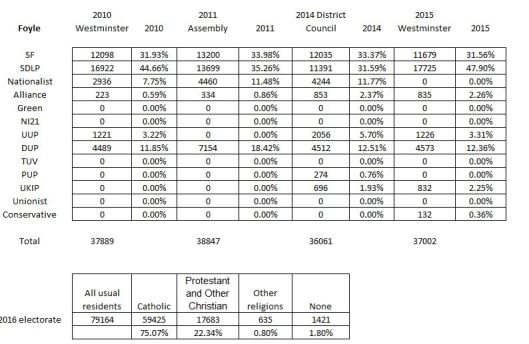
Foyle is unlikely to have any changes in this election. For years there has been speculation that SF could take 3 seats. Indeed, in the 2014 Council elections the SF vote exceeded the SDLP vote by 1.7%. However, for elections since 2005 the SF vote has been in the 31% to 34% range with no sign of a breakout from that level. There has also been speculation that Eamonn McCann or an independent such as Dr. Anne McCloskey could win a seat. This election is significant in that the leaders of both the nationalist parties are standing in the constituency. The advantage of having a party leader contesting a constituency is that it may increase the total party vote. The disadvantage is that it can result in poor balancing, with the party leader far above a quota. In Foyle the presence of both Martin McGuiness and Colum Eastwood is likely to reduce the 1st preference vote for PBP and independents. I do not believe that SF, PBP or Anne McCloskey can take a seat from the SDLP. There is usually a unionist surplus of 6% and in 2011 80% of that surplus eventually ended up with SDLP candidates. The DUP have been attempting to increase unionist turnout by claiming that the unionist seat is under threat. This is aimed at unionist voters who do not understand the demographics of the constituency. It would require another 10,000 nationalist votes for the DUP to lose their seat, a scenario that will not occur. On the unionist side the only area of interest is the size of the UUP vote and that of the former DUP MLA Maurice Devenney.
Newry and Armagh
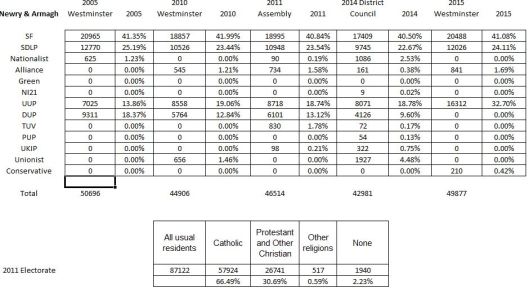
There are 2 main contests here. The 1st is between SF and the SDLP and the 2nd is between the DUP and UUP with both the UUP and the SDLP hoping to pick up additional seats. In the 2011 election the SDLP lost the 2nd seat due to poor balancing and the lack of transfers. In the final count there was an undistributed SDLP surplus of 478 and the 2nd SDLP candidate lost by only 611. With proper balancing the 2nd candidate would have lost by only 133 votes. There was a UUP surplus of 857 but the majority did not give the SDLP any preference. There were also over 1,400 UKIP voters who gave no preference to the SDLP (it appears that less than 5% of those voters gave any preference to the SDLP). The SDLP vote improved marginally in 2015 compared to 2011 so this will be a very close contest for the 4th nationalist seat. It will depend on balancing among the candidates and transfers. There is also an independent republican, Martin McAllister standing who will take 1st preference votes from SF. Not all of his votes may transfer to SF. Another factor is that there are 3,000 EU nationals on the register who could not vote in the Westminster election. SF needs 60% of those to keep pace with the SDLP and those voters may well decide the outcome. Another issue is the pending Brexit referendum. Brexit would affect this constituency more than most and border restrictions would affect travel and trade. This may result in a higher nationalist turnout.
The UUP were shrewd in standing 2 candidates and I would give the edge to the UUP to elect 2 for several reasons. If you look at the 2014 Council results the UUP vote is almost twice the DUP vote. With Alliance and Green transfers it would be more than twice the DUP vote. The UUP were the Unity candidates in 2015 and not all of those DUP votes lent to the UUP may return to the DUP. Paul Berry, previously of the DUP, is standing and will reduce the DUP 1st preference vote. His transfers may not all return to the DUP. The Brexit referendum will also affect the unionist vote. Since the UUP is opposed to Brexit and the DUP in favour of Brexit unionist farmers and other unionists opposed to Brexit may vote UUP.
South Down
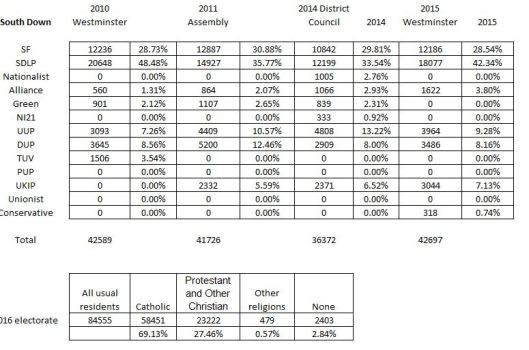
In the previous 6 constituencies I discussed there is no realistic possibility that a current unionist seat could be lost to a nationalist candidate. It is certainly possible that SF could take seats from the unionist bloc in East Derry and Fermanagh South Tyrone but it would take a massive increase in nationalist turnout that is unlikely to occur. This is the 1st constituency where there is a reasonable possibility that the SDLP could take one of the unionist seats. There have been major demographic changes in South Down since 2011 and census data and death rates indicate there is an increase of 3,400 voters from the Catholic community versus only 100 from the Protestant community. The demographic changes appear to be evident in the 2014 and 2015 elections. In 2014 SF was 1.2% above 2 quotas while the SDLP was 9% short of 3 quotas. The unionist bloc was 1% short of 2 quotas. There was a 9% vote for Alliance, Green and NI21 and independent nationalists and the unionist bloc could depend on at least 2% of those for transfers and end up with 1% over 2 quotas. The turnout for 2015 Westminster was much higher, on the level of an Assembly election, but there was some tactical unionist voting for the SDLP. I estimate the unionist vote would be 1,000 higher without the tactical voting. With that extra 1,000 and some Alliance transfers there would have been exactly 2 unionist quotas. 2016 should be very close. There are some factors that will affect the 2016 vote compared to 2015. There are 1,200 EU national voters who may vote in the Assembly election and with the pending Brexit referendum they may be motivated to vote for pro EU parties. The nature of the competition among unionist candidates also favours the SDLP for a 3rd seat. Jim McAllister the former UUP MLA and Harold McKee the new UUP candidate will be competing for the UUP type voters. One will be eliminated. If the UUP is eliminated first their voters may be reluctant to transfer to Jim McAllister since he abandoned the party. Some may transfer instead to the DUP, TUV or even SDLP or may not transfer to anyone. Henry Reilly will be a strong candidate for the TUV. He switched from UKIP to the TUV but there appear to be little in the way of hard feeling locally since UKIP decided not to contest South Down. Henry Reilly was only 1% behind the DUP in 2015 and could win a seat for the TUV here if Jim Wells is eliminated in the later counts. What may hurt Jim Wells in South Down are the cutbacks in services at Downe Hospital. Services at the hospital have been threatened and this has occurred when Edwin Poots and Jim Wells were the health ministers. Expect the last count to be very close between the 3rd SDLP candidate and a unionist.
Upper Bann
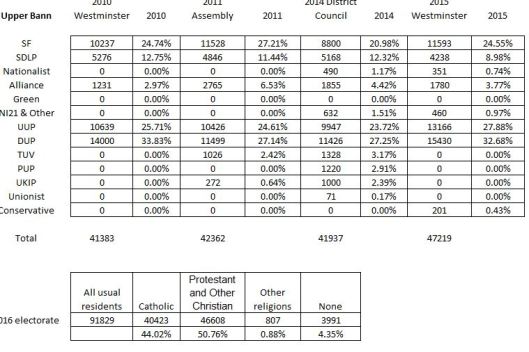
This is one constituency where nationalist voter apathy is a major factor. In the 2011 Assembly election the 2nd SF candidate was only 400 votes behind the 2nd UUP candidate who was elected on the final count. What has happened since then? In 2015 the total nationalist vote actually declined compared to 2011 while the total unionist vote increased by 5,500. In 2015, unionist turnout was over 60% and nationalist turnout was only 40%. Since it unlikely that these additional unionist voters will stay home in 2016 the nationalist vote would need to increase by 5,000 in order to reach 3 quotas. On paper, there should be 3 nationalist seats. Excluding the Others and None’s the Catholic electorate is 46.5% and the Protestant electorate in 53.5%. Between 2011 and 2016 the Catholic community electorate has increased by 2,300 while the Protestant community electorate has increased by only 300. Clearly the potential nationalist vote with equal turnout is far above 3 quotas (42.9%). I doubt that the SDLP will lose a seat here. In the 2014 Council elections the SDLP vote was 12.3% and with Alliance and NI21 transfers would have exceeded a quota of 14.3%. SF is far from 2 quotas. Is there any way SF can find an additional 5,000 nationalist voters? Upper Bann does have over 4,500 EU nationals on the electoral register and these voters should be motivated to vote for pro EU parties in view of the pending Brexit referendum. Whether SF and the SDLP will even attempt to target and canvass these voters is unknown. If even half voted then SF would still need an additional 2,500 native nationalist voters to win a 2nd seat.
North Antrim
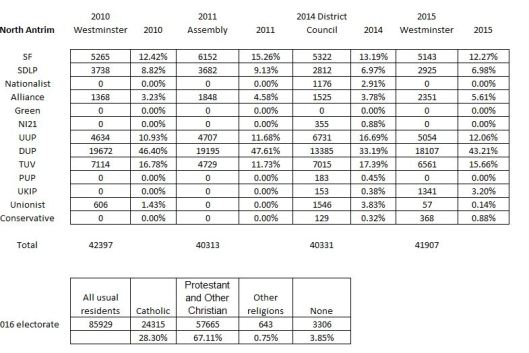
North Antrim would be the most likely constituency where there could be a unionist loss, in this case to the SDLP. If you look at the 2011 election Declan O’Loan of the SDLP lost to Jim Allister of the TUV by 600 votes in the last count. In 2016 there are several factors in favour of the SDLP and one factor against the SDLP. The demographic changes over the past 5 years indicate a 1,500 increase in the Catholic electorate versus an 800 increase in the Protestant electorate. If half of those voters vote the gap would only 300 votes. There are also Green and Labour candidates in 2016 which may draw out a few more voters that could transfer to the SDLP. Finally, there is a change in the nature of the unionist vote in 2016. In 2011, the UUP received 600 Alliance transfers which were needed to elect the UUP candidate. In the 2014 Council election the UUP vote was 16.7% which is above a quota so those Alliance transfers will end up with their 3rd preference, some of which will be SDLP rather than DUP or TUV. On the other hand there is one major factor favouring unionist candidates in 2016. In 2011, Evelynne Robinson of the DUP was eliminated at stage 8 but 766 of her votes did not transfer to the remaining DUP candidate nor any other candidate. This is unusual and is unlikely to recur in 2016. In the end there should be 1 SF, 1 UUP, 2 DUP and 1 TUV candidate elected with the last seat to be won by either the SDLP or the remaining unionist candidate (either DUP or TUV). This is one constituency where the pending Brexit referendum may determine the outcome. There are 2,000 EU nationals on the electoral register most of whom were not registered in 2011. If they vote for the SDLP in significant numbers they could defeat a pro Brexit TUV or DUP candidate.



